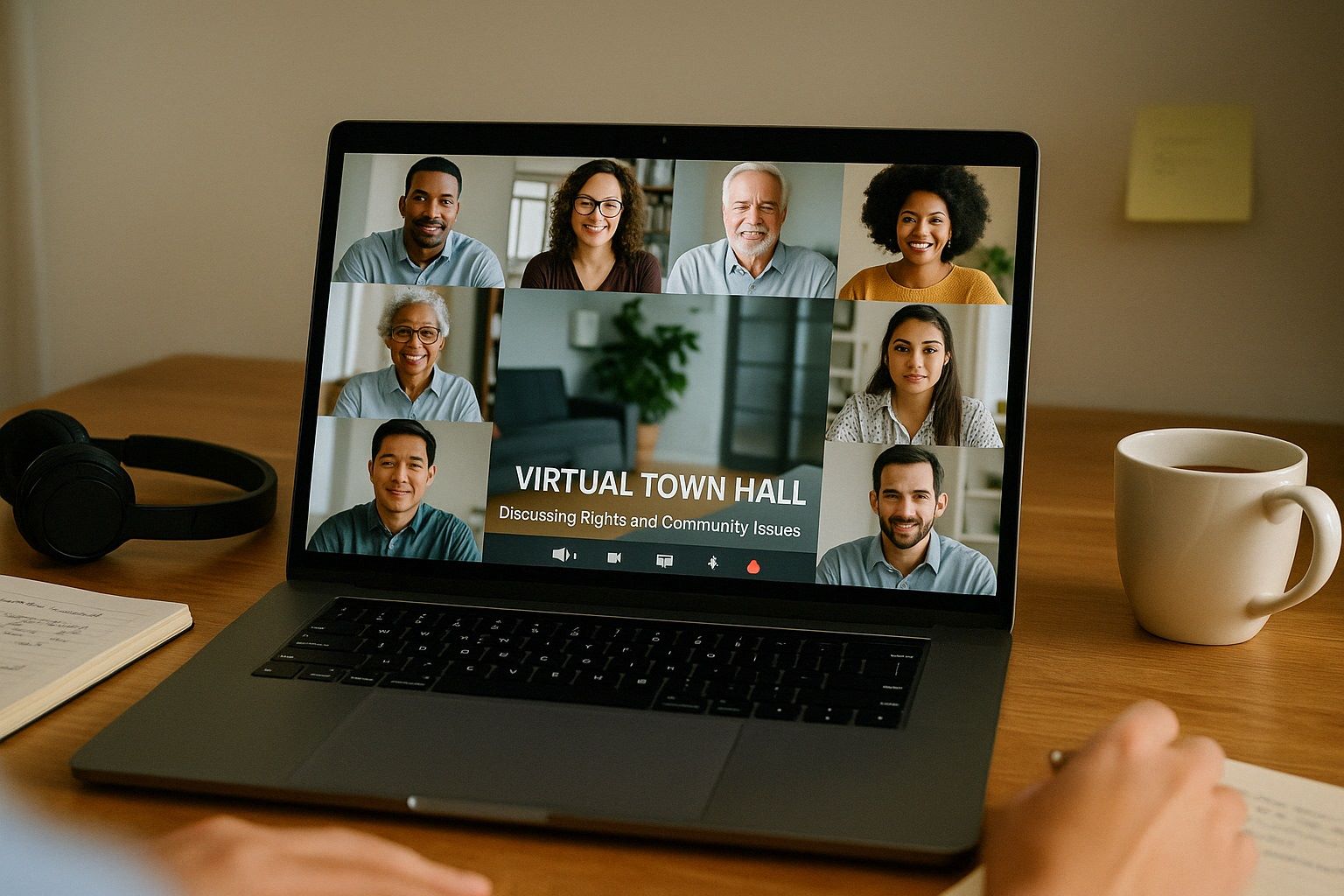
Host Virtual Town Halls for Rights Discussion
Conversations about human rights need space to grow. People want to share stories, ask questions, and understand how the law affects their lives. But not everyone can attend a local meeting or travel to a legal aid office. That’s where virtual town halls come in. They bring the discussion directly to people’s screens—making it easier to speak up, listen, and learn from wherever they are.
Hosting a virtual town hall lets legal aid groups, NGOs, and community leaders reach more people. It creates a space for real-time dialogue, especially for those in rural areas, with mobility challenges, or balancing work and family responsibilities. These sessions don’t replace traditional outreach—they expand it.
What You’ll Learn About Hosting Meaningful Online Town Halls
Virtual town halls can open the door to deeper community engagement. This article offers practical steps for setting up and running one, from choosing the right platform to encouraging honest discussion. It covers how to prepare speakers, structure the session, and follow up with clear action items.
You’ll also find ways to make sure your town hall includes diverse voices and remains welcoming, respectful, and grounded in the issues people care about. The goal is to build stronger connections and make rights-related conversations more accessible to everyone.
Start With a Clear Focus
A successful town hall begins with purpose. What topic are you tackling? Is it about tenants’ rights, access to legal aid, press freedom, or police accountability? Picking a specific issue helps attract people who are most affected—and gives the discussion direction.
Once you know your focus, think about who should be involved. That might include a legal expert, a community organizer, or someone with lived experience. These speakers bring depth and keep the conversation grounded in reality.
The clearer your goal, the easier it is to promote the event, prepare questions, and manage the time.
Choose Tools That Fit Your Audience
Not every audience has access to high-speed internet or familiarity with online tools. That’s why it’s helpful to pick a platform that’s easy to join, even by phone. Zoom, Google Meet, and Facebook Live are popular options. Some allow live captions, multiple languages, or text-based participation—which helps reach more people.
It’s also good to test the tech before going live. A quick run-through with speakers ensures everyone knows how to unmute, share slides, or answer questions. If possible, assign someone to help manage chat questions or tech issues during the session.
Accessibility matters. When people feel comfortable joining, they’re more likely to return and recommend the event to others.
Make the Format Welcoming and Interactive
People don’t just want to be talked at—they want to feel part of the conversation. A short introduction by the host can set a warm tone. Clear rules, like keeping comments respectful or allowing anonymous questions, help create a safe space.
Break up long presentations with pauses for questions. If possible, use polls or open prompts to invite input. Something as simple as “What’s the biggest challenge you face right now?” can bring rich responses and spark discussion.
Letting participants know how to follow up—through email, WhatsApp, or a follow-up form—keeps the conversation going.
Include a Range of Voices
A meaningful discussion about rights should reflect the diversity of those affected. That means inviting speakers and participants from different backgrounds, age groups, regions, and experiences. If you’re talking about access to justice, include someone who’s had to navigate the system themselves.
When people hear stories they recognize, they feel more connected and more likely to contribute. A town hall becomes more than an event—it becomes a mirror that shows the full picture of a community.
Diverse voices also bring different solutions, helping shape more inclusive strategies going forward.
Prepare Speakers to Share Clearly
Not every speaker is used to virtual formats. A little preparation helps them feel more confident. Encourage them to speak plainly, avoid jargon, and focus on stories or examples that connect with everyday life.
If they’re covering legal topics, remind them to share basic definitions and real-life applications. This helps participants leave with something useful—whether it’s a phone number to call or a right they didn’t know they had.
Clarity builds trust. It also encourages more people to return for future town halls.
Give People a Way to Act
Discussion is powerful, but action makes it stick. At the end of the town hall, share one or two ways people can get involved. Maybe it’s signing up for a legal aid clinic, joining a community meeting, or following your organization for updates.
When people feel they’ve learned something and know what to do next, they’re more likely to stay engaged.
You can also invite feedback. A short follow-up form or comment in the chat can help shape the next event and show that you’re listening.
Keep the Conversation Going
One town hall won’t solve every issue, but it can start momentum. Regular sessions—monthly, quarterly, or tied to specific events—create rhythm and continuity.
Posting summaries, sharing recordings, or sending out thank-you emails helps keep people informed and included. Tagging participants (with permission) or highlighting powerful moments also reminds others of the value of the discussion.
Building community takes time, and virtual town halls offer a low-cost, flexible way to support that effort.
Build Trust, One Conversation at a Time
Virtual town halls work best when they feel real. When people log in and see others who care, share, and speak openly, it creates a sense of belonging. That connection is the foundation for action, advocacy, and support.
Legal aid isn’t just about solving cases—it’s about creating space for people to understand their rights and use their voice. Hosting these events is one way to do that. One screen, one voice, one story at a time.
